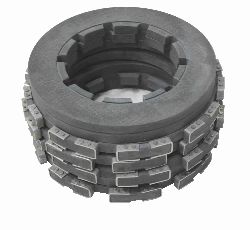 With the rapid development of modern aviation technology, the research of aircraft brake friction materials is more and more important. During the instantaneous brake,almost all the kinetic energy will transform into heat energy,and emited by the braking material,the temperature of the dics will reach 1000~1500℃.
With the rapid development of modern aviation technology, the research of aircraft brake friction materials is more and more important. During the instantaneous brake,almost all the kinetic energy will transform into heat energy,and emited by the braking material,the temperature of the dics will reach 1000~1500℃.
C/C composites is the latest aircraft friction material and their friction and wear properties are very important.Friction and wear properties of C/C composites from different techniques were studied and effects of braking speeds and pressure were also analyzed by most scholars.the optical microscopy,scanning electron microscopy,X-ray diffraction,laser Raman micro-spectroscopy are used to examine the morphology and structure of worn surfaces.
Studies showed that C/C composites mainly with rough laminar pyrolytic carbon have small uniform wear debris and the most stable friction and wear properties,which can maintain at high braking speeds and pressure and the linear wear is under 2μm/plate.time,owing to the highest degrees of graphitization and thermal conductivities. And C/C composites mainly with smooth laminar pyrolytic carbon have unstable properties of friction and wear owing to lower graphitization degrees and thermal conductivities. And C/C composites impregnated only by pitch have the highest wear rates and the linear wear is up to 27.33μm/plate.time.
The properties of C/C composites braking dics has a relationship with the CVD and friction film,the braking speed,braking pressure etc.
Some new types of military aircraft and some large civil aircrafts,C/C composites could replace the powder metallurgy.
The C/C composites material impregnated metals like C/C+Cu,C/C+Al,which have perfect integrate capability to be used as pantograph sliders and used in the speed-upping electrical locomotive.it’s also one of the main development direction of C/C composites materials.